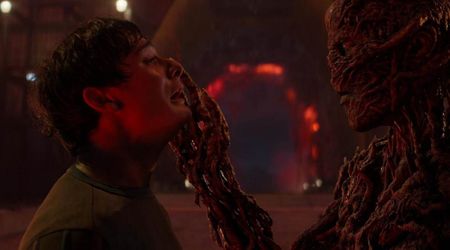‘I'll Be Gone In The Dark’: The real story of Michelle McNamara's obsessive hunt for The Golden State Killer

Michelle McNamara. The name probably does not ring a bell, but it should. The late wife of comedian-actor Patton Oswalt, McNamara spent the last nine years of her life obsessed with a serial killer she felt should have received just as much attention as the infamous Zodiac Killer, but didn't: a murderer she dubbed the 'Golden State Killer,' who back in his heyday was more commonly referred to as the 'Original Night Stalker' or the 'East Area Rapist.'
McNamara chanced upon the mystery while browsing through A&E's Cold Case Files message boards of fellow internet sleuths who thought they could unmask the elusive killer himself.
But unlike these random denizens of the internet, McNamara had an origin story that propelled and inspired her to relentlessly pursue this ski-mask donning, sadistic, mid-20s murderer who claimed over 60 victims in California's middle and upper-class neighborhoods in the late 70s and early 80s.

Having studied for an MFA in fiction, McNamara decided to put her education and exemplary writing skills to use by documenting the progress of her own search for the killer on her website TrueCrimeDiary.com, as well as in a book she was writing: 'I'll Be Gone in the Dark: One Woman's Obsessive Search For The Golden State Killer.'
The initial part of the title paraphrases what the killer allegedly whispered to one of his victims before he raped and bludgeoned them to death, and so possessed was she with getting to the bottom of the mystery, that she would forgo sleep, and in the process, her health in her quest. It would cost her her life.
The book was never completed, at least, not by her. Paramedics pronounced her dead on the afternoon of April 21, 2016, just a week after her 46th birthday. She had died of an accidental overdose due to an unattributed heart condition that caused blockages in her arteries and a combination of Adderall, Xanax, and Fentanyl that she was probably taking to help manage the stress of investigating and writing at the same time. She left behind a grieving husband, a 7-year-old daughter, five older siblings, and plenty of friends.
But her life's work would not be undone by the simple matter of her death. The book was posthumously published earlier this year by her fellow researcher Paul Haynes, and colleague and investigative journalist Billy Jensen, who were no doubt helped by the comprehensive and exhaustive records McNamara kept detailing her progress in the search for the Golden State Killer.

Husband Patton Oswalt seems to be doing his part to preserve his wife's legacy as well. He will be the executive producer of a docuseries on the book to be produced by HBO, which will recount McNamara's personal obsession with the case and will attempt to peek into the psyche of a man many victims described as a "hyperventilating, under-endowed man-child who cries for his mother."
While there are thousands of crime writers who could lay claim to more thrilling accounts compared to 'I'll Be Gone in the Dark,' what makes the book so special is summarized best by Jennifer Barth, who oversaw the editing process at Harper Collins. She said: "This felt transcendent. It was the voice, the way she writes so intimately about crime, but doesn’t sensationalize it; she is very aware of the victims. And she even manages to humanize the criminal, which is not sensationalized."
McNamara's addition of that personal touch that set the book apart from the rest can be traced back to her fascination with these so-called cold cases stemming from an incident in her childhood.
Her friend Kera Bolonik wrote in Vulture, that at the age of seven, she would leave fake ransom notes around her cul-de-sac block in Oak Park, Illinois, best known for being home to literary legend Ernest Hemmingway.

Then, when she was just 14-years-old, a woman named Kathleen Lombardo, who she knew from church, was murdered in cold blood while jogging a block and a half away from the teen's home.
The killer was never caught, and the fact that such a crime would go unpunished, and that life could return to normal in as much as a blink of an eye never sat right with her and would push her to go unimaginable distances in her hunt for the Golden State Killer.
Her target was initially known as the East Area Rapist for the 50 rapes he committed between June 18, 1976, and July 5, 1979, in the unincorporated areas of Carmichael, Citrus Heights, and Rancho Cordova. His modus operandi was to stalk middle to upper-class neighborhoods at night looking for women who lived in single-story homes, generally located near open spaces so he could make his escape if it came down to it.
As part of his scrupulous surveillance, he would call his victims both before and after the night of the attack, sometimes hanging up, sometimes pretending to have the wrong number, and sometimes threatening them. While he took care to hide his face from his victims, he was described by survivors as wearing an open ski mask, having wide eyes, a wide mouth, and very few identifying features.

From rape, he then graduated to murder. Between 1979 and 1986, he is thought to have killed 12 people in Southern California, most of whom were couples. While his MO was unspectacular, he had some incredibly odd tendencies and psychotic idiosyncrasies. McNamara wrote that he was driven by a passionate hate for nuclear families and was jealous of personal connections, thus forcing women to re-enact intimate sexual acts that he had spied through their windows during surveillance, on him, while forcing the partner to watch.
He also tauntingly left a self-help book on assertiveness at a husband's bedside table after tying him up and forcing him to listen to his wife being brutally raped. She also wrote that he was big on spite and enraged by domesticity, tearing up family photos, breaking picture frames, unplugging appliances, and stealing single earrings from pairs, theorizing that he may have been abandoned as a child.
The Golden State Killer also had a propensity for the theatrical. In December 1977, he sent poems to the editor of the Sacramento Bee, the Sacramento mayor's office, and a local television station titled 'Excitement's Crave' after successfully evading capture by law enforcement earlier in the month. There will also be numerous notebook pages found at the scene of an attack detailing seemingly random topics such as General George Armstrong Custer and the least favorite year of his life, sixth grade. McNamara described these tendencies as the killer's craving to become "the star and director of the movie spooling in [his] head."

But because DNA profiling was not developed till 1984 and because these crimes occurred in different jurisdictions that often did not share information with one another, it wasn't until 2001 - over 15 years since the last crime - that several of the Northern California rapes were linked to the murders in Southern California.
Quite obviously, a case of this magnitude that had gone unsolved for close to three decades by some of the brightest minds in law enforcement would be a tough nut to crack, but there was no one better equipped than McNamara to tackle it head-on. While she continued to accompany her husband on the red carpet, her mind rarely wandered away from her obsession for more than a few hours at a time.
It seemed as though that obsession had paid off as well. A few months before her death, she genuinely believed she had had a breakthrough. A trip to the Orange County Sheriff's Office in January 2016 ended with her and Haynes walking away with 40 boxes of evidentiary materials, most of which had not been combed through. Somewhere in those boxes, McNamara believed, was the elusive name of the killer who had stumped and outsmarted authorities for decades.
Addressing the killer directly on the advancements in technology, criminology and DNA profiling that had streamlined and focused attempts at apprehending serial killers such as himself, she wrote: "After May 4, 1986, you disappear. Some think you died. Or went to prison. Not me. I think you bailed when the world began to change. You cut out when you looked over your shoulder and saw your opponents gaining on you."
At the time of her death, McNamara had only poured through roughly a quarter of those 40 boxes. But she left behind a treasure trove of notes, transcripts with criminalists and detectives, and interviews with the family members of the victims that would help Haynes and Jensen complete the book as she saw fit.
In the last chapter of her thrilling, invigorating book 'Letter to an Old Man,' McNamara writes: "The race was yours to win." But this wasn't as much an admittance of defeat as it was her proclaiming that, given more time, the net that she helped build and cast would inevitably close down on the killer and ensure that he's brought to justice.
On June 15, 2016, the FBI and local law enforcement agencies held a news conference to announce a nationwide hunt and a $50,000 reward for his capture. The agency plans to erect electronic billboards nationwide and use other forms of exposure to push for the closure of a case that has proven to be a thorn in their side and a blot in their record for far too long. But when and if they do apprehend there should be little doubt that McNamara aided their efforts immeasurably.










